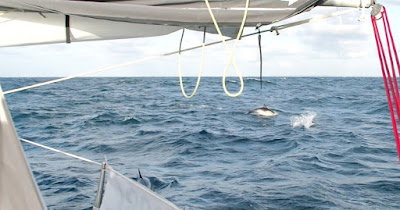Are important in case of an accidental gybe or a downwind broach. Lack of one can damage the rig, usually the goose neck, knock people overboard, even kill someone with a crack to the head. It is even more important single handed – there is no one to come and pick you up if knocked overboard or tend a broken skull – and whilst a wind vane or autopilot linked to the wind instruments are as good as or better than a helmsman at avoiding the gybe the systems can’t see big waves coming so a gybe is always a possibility. A preventer is also good at reducing chafe by stabilising the boom and is useful in light winds with a choppy sea.
Rigging one from scratch can be time consuming and potentially dangerous if, as they should be, they are rigged to the end of the boom and from the eyes of the boat.
There are two main options: Permanently rig a preventer on each side, this speeds things up and only requires a quick visit to the boom to release it from its stowage and it is quick to deploy when gybing, but on a small boat there are already a lot of lines getting in your way and this would add 4 runs going over the foredeck.
My preferred option is to rig a standing part from the end of the boom with a spliced stainless steel thimble at the other end stowed near the gooseneck. A line from the bow is then clipped to it when required. I have a choice of three permanently rigged lines to do that all going back to the cockpit. If a lot of gybes are likely in a fresh wind, I might rig a 2nd preventer which saves time and a trip out of the cockpit to pass a single line round the mast.
 |
| Rigged preventer, I have a reef in – not sure why, probably I was having a leisurely breakfast after a windy night crossing Lyme Bay. And some dolphins. |
 |
| The finished end at the Boom. This has now been replaced by a line with a stainless thimble and this line relegated to a back up. |
A preventer should be made off to either a traditional cleat (a winch is not needed to set a preventer) or to a clutch with a winch available, preferably in the cockpit. After an unintended gybe, the mainsail may have to be let round in a controlled manner, that can’t be done with a cam or clam cleat (unless you can get the tail to a winch then keep the line out of the cleat).
There are two schools of thought about the type of line to use, some want it as strong as possible so prefer expensive Dyneema, others prefer some elasticity in case the boom goes in the water and prefer nylon. Sancerre does not normally put her (short) boom near the water so I am in the middle and use 10mm polyester braid on braid.
Some like to insert a weak link that will break before the rig does, I am sceptical, it largely negates the purpose of the preventer and is potentially dangerous - I don't want to be hit by the boom! With a small mainsail and a boom normally well clear of the water, I would hope that the problem will not arise.
No comments:
Post a Comment